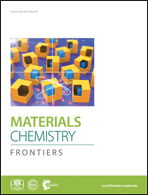Facile construction of butadiynylene based conjugated porous polymers by cost-effective Glaser coupling†
Abstract
A series of butadiynylene (BD) based conjugated microporous polymers (CMPs) were facilely synthesized using various aromatic alkyne monomers with different geometries via a Glaser coupling reaction under mild conditions. All these CMPs form gels in situ after self-polycondensation. The chemical structures, morphologies, surface areas, CO2 and CH4 uptake capacities of the freeze-dried gels were thoroughly characterized. All four CMPs have large specific surface areas (up to 1008 m2 g−1), big total pore volumes (up to 1.11 cm3 g−1), high CO2 uptake capacities (up to 3.78 mmol g−1) and high CH4 adsorption capacities (up to 0.95 mmol g−1). Bearing densely incorporated active sites (C![[triple bond, length as m-dash]](https://www.rsc.org/images/entities/char_e002.gif) C bonds) for the binding of metallic ions (e.g. Li+), excellent porosity, and a conjugated network structure, these BD-CMPs hold great promise for applications in gas adsorption, heavy metal accumulation, heterogeneous catalysis, lithium batteries, etc.
C bonds) for the binding of metallic ions (e.g. Li+), excellent porosity, and a conjugated network structure, these BD-CMPs hold great promise for applications in gas adsorption, heavy metal accumulation, heterogeneous catalysis, lithium batteries, etc.


 Please wait while we load your content...
Please wait while we load your content...